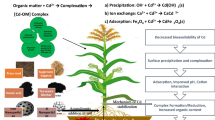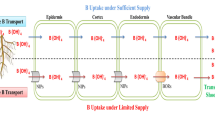Abstract
Plant phytoliths are important for silicon (Si) cycling in natural ecosystems; however, their role in lanthanum (La) sequestration in plants is still unclear. In the present study, we elucidated the mechanism of La-induced damage to the growth of rice (Oryza sativa L.) seedling from the viewpoint of the La sequestration by phytoliths (PhytLa). The phytoliths were extracted by using the microwave digestion method. La concentrations within the plants and phytoliths were determined by a modified lithium metaborate fusion method. Analysis showed that pretreatment with low La concentration not only promoted photosynthesis and transpiration in rice but also enhanced the sequestration ability of phytoliths on La. Conversely, high La concentration inhibited photosynthesis and transpiration in rice and the ability of phytoliths to sequester La. Moreover, high Si concentrations promoted the sequestration ability of phytoliths during these processes. Promotion of combined stress of La and Si on the ability of rice seedling was stronger than that of the single La stress. The sequestration ability of phytoliths in different parts of rice varied significantly, following the order: stem > leaf > root. This pattern could be attributed to factors such as the production of various phytolith morphotypes (such as tubes) and PhytLa, PhytLa efficiency, La accumulation, and the rate of photosynthesis and transpiration in different parts of rice seedlings. This study demonstrated that La uptake in rice seedlings was affected by the presence of Si in the medium, and phytolith played a crucial role in the bio-sequestration of La and assuaged the damage caused by La in rice seedlings.

ᅟ







Similar content being viewed by others
Abbreviations
- PhytLa:
-
La sequestrated by phytoliths
- REE:
-
Rare earth element
- Ca + b/Ca/b:
-
Chlorophyll a + b/chlorophyll a/b
- EDTA:
-
Ethylenediaminetetraacetic acid
- ICP-AES:
-
Inductively coupled plasma-atomic emission spectroscopy
- PLCO:
-
PhytLa content of organs
- PLSA:
-
Sequestration ability of phytoliths on La
- Pn:
-
Net photosynthetic rate
- Gs:
-
Stomatal conductance
- Tr:
-
Transpiration rate
- DMSO:
-
Dimethyl sulfoxide
- BSi:
-
Biogenic silicon
References
Aragay G, Pons J, Merkoci A (2011) Recent trends in macro-, micro-, and nanomaterial-based tools and strategies for heavy-metal detection. Chem Rev 111:3433–3458
Biasioli M, Fabietti G, Barberis R, Ajmone-Marsan F (2012) An appraisal of soil diffuse contamination in an industrial district in northern Italy. Chemosphere 88(10):1241–1249. https://doi.org/10.1016/j.chemosphere.2012.03.081
Blecker SW, Mcculley RL, Chadwick OA, Kelly EF (2006) Biologic cycling of silica across a grassland bioclimosequence. Glob Biogeochem Cycles 20:4253–4274
Carter JA (2009) Atmospheric carbon isotope signatures in phytolith-occluded carbon. Quat Int 193(1-2):20–29. https://doi.org/10.1016/j.quaint.2007.11.013
Dove PM (1995) Kinetic and thermodynamic controls on silica reactivity in weathering environments. Rev Mineral Geochem 31:235–290
Dove PM, Crerar DA (1990) Kinetics of quartz dissolution in electrolyte solutions using a hydrothermal mixed flow reactor. Geochim Cosmochim Acta 54(4):955–969. https://doi.org/10.1016/0016-7037(90)90431-J
EPA/600/R-12/572 (2012) Rare earth elements: a review of production, processing, recycling, and associated environmental issues. Office of Research and Development EPA/600/R-12/572
Epstein E (1999) Silicon. Annu Rev Plant Physiol Plant Mol Biol 50(1):641–664. https://doi.org/10.1146/annurev.arplant.50.1.641
Epstein E (2001) Silicon in plants: facts vs concepts. In: Datnoff LE, Snyder GH, Korndorfer GH (eds) Silicon in agriculture. Elsevier, Amsterdam, pp 1–15. https://doi.org/10.1016/S0928-3420(01)80005-7
García-Jiménez A, Gómez-Merino FC, Tejeda-Sartorius O, Trejo-Téllez LI (2017) Lanthanum affects bell pepper seedling quality depending on the genotype and time of exposure by differentially modifying plant height, stem diameter and concentrations of chlorophylls, sugars, amino acids, and proteins. Front Plant Sci 8:308
Guntzer F, Keller C, Poulton PR, Mcgrath SP, Meunier JD (2012) Long-term removal of wheat straw decreases soil amorphous silica at Broadbalk, Rothamsted. Plant Soil 352(1-2):173–184. https://doi.org/10.1007/s11104-011-0987-4
Guo F, Song Z, Sullivan L, Wang H, Liu X, Wang X et al (2015) Enhancing phytolith carbon sequestration in rice ecosystems through basalt powder amendment. Chin Sci Bull 60:591–597
Handreck KA, Jones LHP (1968) Studies of silica in the oat plant. IV. Silica content of plant parts in relation to stage of growth, supply of silica, and transpiration. Plant Soil 29(3):449–459. https://doi.org/10.1007/BF01348976
Haynes RJ (2017) The nature of biogenic Si and its potential role in Si supply in agricultural soils. Agric Ecosyst Environ 245:100–111. https://doi.org/10.1016/j.agee.2017.04.021
Hodson MJ, Sangster AG (1999) Aluminium/silicon interactions in conifers. J Inorg Biochem 76(2):89–98. https://doi.org/10.1016/S0162-0134(99)00119-1
Hu ZY, Richter H, Sparovek G, Schnug E (2004) Physiological and biochemical effects of rare earth elements on plants and their agricultural significance: a review. J Plant Nutr 27(1):183–220. https://doi.org/10.1081/PLN-120027555
Hu Z, Haneklaus S, Sparovek G, Schnug E (2006) Rare earth elements in soils. Commun Soil Sci Plant Anal 37(9-10):1381–1420. https://doi.org/10.1080/00103620600628680
Hu H, Wang L, Li Y, Sun J, Zhou Q, Huang X (2016) Insight into mechanism of lanthanum (III) induced damage to plant photosynthesis. Ecotoxicol Environ Saf 127:43–50. https://doi.org/10.1016/j.ecoenv.2016.01.008
Huang ZT, Jiang PK, Chang SX, Zhang Y, Ying YQ (2014) Production of carbon occluded in phytolith is season-dependent in a bamboo forest in subtropical china. PLoS One 9(9):e106843. https://doi.org/10.1371/journal.pone.0106843
Ingamels CO (1964) Rapid chemical analysis of silicate rocks. Talanta 11(3):665–666. https://doi.org/10.1016/0039-9140(64)80083-7
Jones LHP, Handreck KA (1965) Studies of silica in the oat plant III. Uptake of silica from soils by plant. Plant Soil 23(1):79–96. https://doi.org/10.1007/BF01349120
Kameník J, Mizera J, Řanda Z (2013) Chemical composition of plant silica phytoliths. Environ Chem Lett 11:189–195
Keller C, Guntzer F, Barboni D, Labreuche J, Meunier JD (2012) Impact of agriculture on the Si biogeochemical cycle: input from phytolith studies. Compt Rendus Géosci 344(11-12):739–746. https://doi.org/10.1016/j.crte.2012.10.004
Li Z, Song Z, Parr JF, Wang H (2013a) Occluded C in rice phytoliths: implications to biogeochemical carbon sequestration. Plant Soil 370(1-2):615–623. https://doi.org/10.1007/s11104-013-1661-9
Li X, Chen Z, Chen Z, Zhang Y (2013b) A human health risk assessment of rare earth elements in soil and vegetables from a mining area in Fujian Province, Southeast china. Chemosphere 93(6):1240–1246. https://doi.org/10.1016/j.chemosphere.2013.06.085
Lichtenthaler HK (1987) Chlorophylls and carotenoids: pigments of photosynthetic biomembranes. Methods Enzymol 148:350–382. https://doi.org/10.1016/0076-6879(87)48036-1
Liu RQ, Xu XJ, Wang S, Shan CJ (2016) Lanthanum improves salt tolerance of maize seedlings. Photosynthetica 54(1):148–151. https://doi.org/10.1007/s11099-015-0157-7
Lu H, Zhang J, Wu N, Liu KB, Xu D, Li Q (2009) Phytoliths analysis for the discrimination of foxtail millet (Setaria italica) and common millet (Panicum miliaceum). PLoS One 4(2):e4448. https://doi.org/10.1371/journal.pone.0004448
Ma JF, Yamaji N (2006) Silicon uptake and accumulation in higher plants. Trends Plant Sci 11(8):392–397. https://doi.org/10.1016/j.tplants.2006.06.007
Ma JF, Tamai K, Yamaji N, Mitani N, Konishi S, Katsuhara M, Ishiguro M, Murata Y, Yano M (2006) A silicon transporter in rice. Nature 440:688–691
Meunier JD, Colin F, Alarcon C (1999) Biogenic silica storage in soils. Geology 27:835–838
Mitani N, Ma JF, Iwashita T (2005) Identification of the silicon form in xylem sap of rice (Oryza sativa L.) Plant Cell Physiol 46(2):279–283. https://doi.org/10.1093/pcp/pci018
Mortlock RA, Froelich PN (1989) A simple method for the rapid determination of biogenic opal in pelagic marine sediments. Deep Sea Res A Oceanogr Res Pap 36(9):1415–1426. https://doi.org/10.1016/0198-0149(89)90092-7
Nguyen NM, Dultz S, Guggenberger G (2014) Effects of pretreatment and solution chemistry on solubility of rice-straw phytoliths. J Plant Nutr Soil Sci 17:349–359
Okuda A, Takahashi E (1962) Studies on the physiological role of silicon in crop plant. Part 8. Some examination on the specific behavior of low land rice in silicon uptake. J Sci Soil Manure Jpn 33:217–221
Parr JF, Sullivan LA (2011) Phytolith occluded carbon and silica variability in wheat cultivars. Plant Soil 342(1-2):165–171. https://doi.org/10.1007/s11104-010-0680-z
Parr JF, Dolic V, Lancaster G, Boyd WE (2001) A microwave digestion method for the extraction of phytoliths from herbarium specimens. Rev Palaeobot Palynol 116(3-4):203–212. https://doi.org/10.1016/S0034-6667(01)00089-6
Parr J, Sullivan L, Quirk R (2009) Sugarcane phytoliths: encapsulation and sequestration of a long-lived carbon fraction. Sugar Technol 11(1):17–21. https://doi.org/10.1007/s12355-009-0003-y
Piperno DR (2006) Phytoliths: a comprehensive guide for archaeologists and paleoecologists. Econ Bot 60:391–392
Shan X, Wang H, Zhang S, Zhou H, Zheng Y, Yu H, Wen B (2003) Accumulation and uptake of light rare earth elements in a hyperaccumulator dicropteris dichotoma. Plant Sci 165(6):1343–1353. https://doi.org/10.1016/S0168-9452(03)00361-3
Sommer M, Kaczorek D, Kuzyakov Y, Breuer J (2006) Silicon pools and fluxes in soils and landscapes—a review. J Plant Nutr Soil Sci 169(3):310–329. https://doi.org/10.1002/jpln.200521981
Song Z, Wang H, Strong PJ, Li Z, Jiang P (2012a) Plant impact on the coupled terrestrial biogeochemical cycles of silicon and carbon: implications for biogeochemical carbon sequestration. Earth Sci Rev 115(4):319–331. https://doi.org/10.1016/j.earscirev.2012.09.006
Song Z, Liu H, Si Y, Yin Y (2012b) The production of phytoliths in China’s grasslands: implications to the biogeochemical sequestration of atmospheric CO2. Glob Chang Biol 18(12):3647–3653. https://doi.org/10.1111/gcb.12017
Strömberg CAE (2004) Using phytolith assemblages to reconstruct the origin and spread of grass-dominated habitats in the great plains of North America during the Late Eocene to Early Miocene. Palaeogeogr Palaeoclimatol Palaeoecol 207(3-4):239–275. https://doi.org/10.1016/j.palaeo.2003.09.028
Struyf E, Conley D (2012) Emerging understanding of the ecosystem silica filter. Biogeochemistry 107(1-3):9–18. https://doi.org/10.1007/s10533-011-9590-2
Tamai K, Ma JF (2003) Characterization of silicon uptake by rice roots. New Phytol 158(3):431–436. https://doi.org/10.1046/j.1469-8137.2003.00773.x
Taylor SR, Mclennan SM (1985) The continental crust: its composition and evolution. Blackwell Scientific, Oxford 312
Walkley A, Black IA (1934) An examination of the Degtjareff method for determining soil organic matter, and a proposed modification of the chromic acid titration method. Soil Sci 37(1):29–38. https://doi.org/10.1097/00010694-193401000-00003
Wang C, Shi C, Liu L, Wang C, Qiao W, Gu Z, Wang X (2012) Lanthanum element induced imbalance of mineral nutrients, HSP 70 production and DNA-protein crosslink, leading to hormetic response of cell cycle progression in root tips of vicia faba L. seedlings. Dose Response 10(1):96–107. https://doi.org/10.2203/dose-response.11-041.Wang
Wang L, Li J, Zhou Q, Yang G, Ding XL, Li X et al (2014) Rare earth elements activate endocytosis in plant cells. Proc Natl Acad Sci U S A 111(35):12936–12941. https://doi.org/10.1073/pnas.1413376111
Wei Z, Hong F, Yin M, Li H, Hu F, Zhao G, Wong JWC (2005) Subcellular and molecular localization of rare earth elements and structural characterization of yttrium bound chlorophyll a, in naturally grown fern dicranopteris dichotoma. Microchem J 80(1):1–8. https://doi.org/10.1016/j.microc.2004.07.005
Xu X, Zhu W, Wang Z, Witkamp GJ (2003) Accumulation of rare earth elements in maize plants (Zea mays, L.) after application of mixtures of rare earth elements and lanthanum. Plant Soil 252(2):267–277. https://doi.org/10.1023/A:1024715523670
Ye Y, Wang L, Huang X, Lu T, Ding X, Zhou Q, Guo S (2008) Subcellular location of horseradish peroxidase in horseradish leaves treated with La(III), Ce(III) and Tb(III). Ecotoxicol Environ Saf 71(3):677–684. https://doi.org/10.1016/j.ecoenv.2007.11.020
Zeng Q, Zhu JG, Cheng HL, Xie ZB, Chu HY (2006) Phytotoxicity of lanthanum in rice in haplic acrisols and cambisols. Ecotoxicol Environ Saf 64(2):226–233. https://doi.org/10.1016/j.ecoenv.2005.03.016
Zuo XX, Lü HY (2011) Carbon sequestration within millet phytoliths from dry-farming of crops in china. Chin Sci Bull 56(32):3451–3456. https://doi.org/10.1007/s11434-011-4674-x
Zuo XX, Lu HY, Gu ZY (2014) Distribution of soil phytolith-occluded carbon in the Chinese Loess Plateau and its implications for silica–carbon cycles. Plant Soil 374(1-2):223–232. https://doi.org/10.1007/s11104-013-1850-6
Acknowledgements
This research was supported by a Research and Innovation Project for Postgraduates of Higher Education Institutions of Jiangsu Province (KYLX15_1164) and a grant of the National Natural Science Foundation of China (Grant No. 31170477, 21371100, 21501068).
Author information
Authors and Affiliations
Contributions
Y.S. performed the experiment and wrote the paper. Y.S. and L.H.W. analyzed the data. Q.Z., X.H.H. and Y.S. designed the study. All authors discussed the results and commented on the manuscript.
Corresponding authors
Ethics declarations
Conflict of interest
The authors declare that they have no competing interests.
Additional information
Responsible editor: Elena Maestri
Rights and permissions
About this article
Cite this article
Si, Y., Wang, L., Zhou, Q. et al. Effects of lanthanum and silicon stress on bio-sequestration of lanthanum in phytoliths in rice seedlings. Environ Sci Pollut Res 25, 10752–10770 (2018). https://doi.org/10.1007/s11356-018-1360-4
Received:
Accepted:
Published:
Issue Date:
DOI: https://doi.org/10.1007/s11356-018-1360-4




